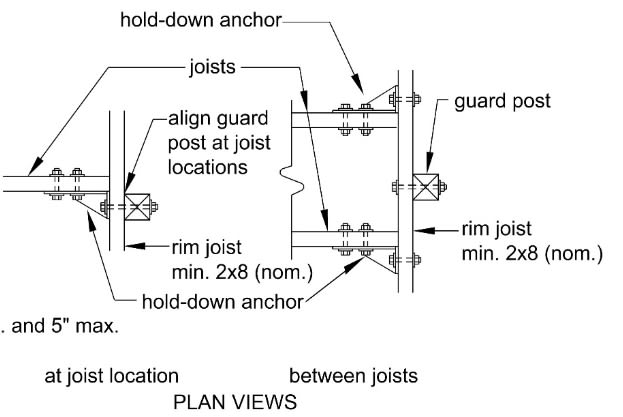For the check of railing post top mounted on deck, is the check of shear and tensile capacity of anchor bolts sufficient?
Considering the point load of 200lbf at top of rail, the 3/8” dia. anchor bolts are checked for shear and tensile capacity induced by moment due to that point load. For the shear capacity check, AISC table 7-1 and 7-2 values are used for bolt capacity. Will these two checks be sufficient? I have carried out the calculation as such:
No. of bolts used in base plate=4
Shear load=200lbf
Shear load per bolt=200/4
Shear capacity of bolt and blocking connection is checked for double shear plane load in AWC connection calculator. The capacity is 784lbf. Hence okay.
Also, from AISC Table 7-1(Shear capacity of bolt), is obtained to be 1485lbf for 3/8” dia bolts. Hence okay in shear.
For tensile force,
Moment (M)=200*42in (Height of rail=42in)
Tensile force on pair of bolt=(M/2)/LEVER ARM BETWEEN SCREWS
This force is checked with tensile capacity of bolt from AISC table 7-2.
Attachment includes the illustration.
Considering the point load of 200lbf at top of rail, the 3/8” dia. anchor bolts are checked for shear and tensile capacity induced by moment due to that point load. For the shear capacity check, AISC table 7-1 and 7-2 values are used for bolt capacity. Will these two checks be sufficient? I have carried out the calculation as such:
No. of bolts used in base plate=4
Shear load=200lbf
Shear load per bolt=200/4
Shear capacity of bolt and blocking connection is checked for double shear plane load in AWC connection calculator. The capacity is 784lbf. Hence okay.
Also, from AISC Table 7-1(Shear capacity of bolt), is obtained to be 1485lbf for 3/8” dia bolts. Hence okay in shear.
For tensile force,
Moment (M)=200*42in (Height of rail=42in)
Tensile force on pair of bolt=(M/2)/LEVER ARM BETWEEN SCREWS
This force is checked with tensile capacity of bolt from AISC table 7-2.
Attachment includes the illustration.

